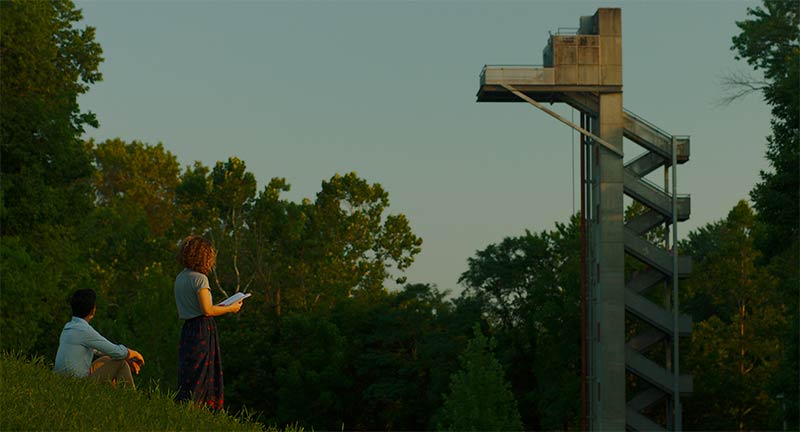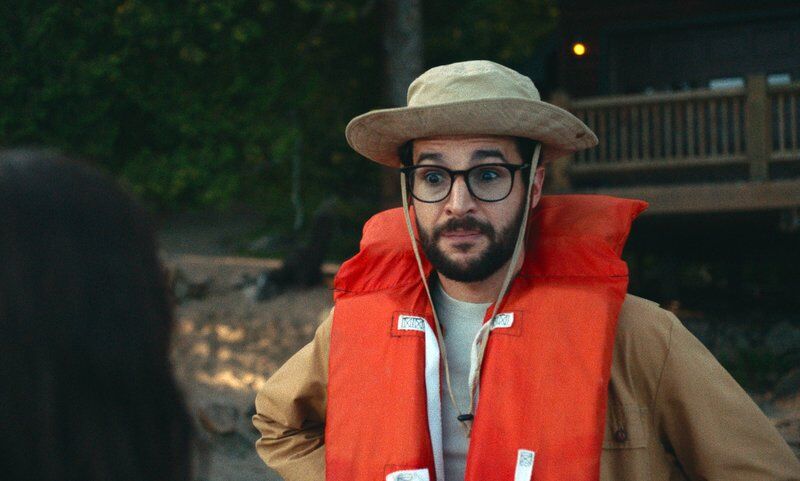Columbus Post Swap with Matthew Johnson. I think I’ve only done one other post swap before. And I have a hard time trusting others on the site. So this is a rare treat for us to all meet Matthew Johnson. Matthew Johnson? Meet everyone. After being introduced to each other by a fellow named Justin – hey Justin – I discovered Matthew’s post about Force Majeure, which is a movie that I loved (both versions, I digress). So much so I realized I hadn’t done my own write up of it as well… (yes, I copied him. Stealing is the strongest form of flattery… or something.) And we got to talking and decided hey – what if we do a post swap? I recommended Columbus to Matt, solely because I want more people to know about this gloriously beautiful film, and I was curious to see what he’d think of it and it seemed the most similar film to Force Majeure in feel.
So, if you haven’t seen the movie Columbus yet – I would liken it to maybe the Before trilogy. Lots of walking and talking. Lots of cool architecture? (Who knew Columbus was an architectural mecca? I did not prior to this movie.) Anyway – don’t continue on if you haven’t seen this marvelous movie… it’ll spoil it, and I’ll be grumpy, you get the idea.
Anyway – without further ado – everyone, Matthew:
Columbus is a 2017 film directed by Koganada and starring John Cho (Jin) , Haley Lu Richardson (Casey), and Parker Posey (Eleanor). The film is so dense with meaning and symbolism and interesting cinematography that it could nearly be broken down scene for scene. At its surface it is another mumblecore movie, but at its core it is so much more.

Columbus centers around the unlikely relationship between Casey and Jin. Casey has recently graduated high school and is living at home with her mother while working part-time at a library. Jin has just arrived from South Korea to attend to his father, a famous architectural professor, who suffered a collapsed at the beginning of the film and is at the hospital.
The film is quiet, slow and naturalistic. It is filled with beautiful interstitial shots of the famous architecture of Columbus. Ozu’s influence on Koganada is apparent. Especially in the way he shoots interiors – framed hallways and bedrooms, where we observe from a slight distance, the action of daily living.
Early on Casey is sitting on the hood of her car staring up at a lit building. We are centered on her face, a face in which Haley Lu Richardson is able to conjure such warmth and powerful emotion. The film cuts and we come back to her in the same view, but her clothes are different. She is in red and her eyes are blotchy and she’s been crying. Time has clearly passed, but it is unspoken and unsaid. Her mother comes out of the hospital just as Jin is walking in to face his father’s condition.
This moment is so revealing and nearly tells the entirety of Casey’s story. The juxtaposition of Jin entering the hospital to face his father and Casey’s mother leaving the hospital to face Casey is intentional and important.
Jin meets with Eleanor, his father’s longtime assistance, and admits his fraught relationship with his father. They have been estranged and Jin believes his father was fine, he had his students and his architecture.
Casey and Jin finally meet. They walk and talk about Jin’s father and Casey’s interest in architecture. Though, it is the second meeting between the two that is truly interesting. She begins describing a building, reciting the facts and interesting tidbits as if a tour guide. Jin stops her and asks what does this building really mean for you. We cut to a shot through the glass of Casey and see a smile on her face as she begins her description, except there is only silence, and we merely see her speaking, rather than hearing it.

There are a number of interesting things going on in this scene. One is the idea of negation, or the power of absence. Earlier in the film we see Jin talking on the phone in Korean, but we have no understanding of the conversation. Just as in this moment, there is a mystery to what is actually occurring. The director allows our imagination to fill in these gaps, because the actual act of doing is more important to the story than the details.
In this instance, any explanation Casey could give as to why the building is so important to her and how it makes her feel would be less powerful than just watching the expression on her face. Any monologue would need to be filled with the greatest poetry to match the feeling we get by just watching, in silence, and imagining. This gives power to the absence, which ends up speaking louder and more powerfully than the other.
We also begin to confront this idea of intellectual interest versus emotional love. This is undercut by the many scenes of tour guides walking through the city explaining to people why the architecture is important or matters. Casey herself confesses to wanting to be a tour guide. Even later in the film we watch Jin walk through a house with Eleanor explaining the importance of certain decorative elements and then later watch Casey repeat these very same facts in the very same house. There is something at play here with the idea of the intellectual versus the emotional.
To undercut this, one could sense the idea of Ozu’s influence on Columbus prior to the knowledge of him being a specific idea to Koganada for this film. Does understanding these visual references provide a greater enjoyment of the film over the emotional response to the characters? Or does knowledge enhance art? If you understood the Lawrence of Arabia homage in John Wick 4 does that make it a better film? All art is referential and can work on this intellectual plane while also evoking an emotional response. Columbus so wonderfully plays with this idea.
On their third meeting, it’s late and Casey drags Jin out to look at a building. It is her first love, she didn’t know anything about it and just saw. She’s unsure of the why, but the building was important to her during a difficult time of life. Here we see the art reaching emotionally without the intellectual footing. Jin and Casey sit in the car staring up at this building while Casey tells the story of Maria, her mother, and her abandonment (addiction to bad relationships) and how Casey feels she must care for her. We see her eyes through the rear-view mirror, but our gaze is the same as theirs, looking up at the building in wonder.
Her eyes and emotions are refracted through the mirror, just as she channels her emotions through the lens of architecture. As a theme, architecture has been important, but in this scene we finally start to see its importance as an emotional gateway for the characters. Just as song, or painting, or film can help explain ourselves to ourselves, or help us process difficult times, so does architecture for Casey.
That early idea of negation becomes more and more important as the story unfolds. The un-said and the un-shown take on greater importance. We see empty interiors, sometimes with Casey or Jin, and sometimes without. What is missing is most important – a father, or mother. By not showing anything, the film tells us everything.
Casey and Jin get end up getting into an argument. Jin is pushing her to take up an offer to study architecture and realize her dreams, but she is unwilling to leave her mother, feeling that Maria “needs” her. (Remember that early scene at the hospital coming and going). Casey gets mad and accuses Jin of not caring since he is just waiting around for his father to die, hoping not to mourn him or really confront his feeling for his father in any way. They part.
Jin’s father is doing worse and he meets with Eleanor again. They share a quiet drink together while he recounts his former love for her. It’s another scene told through a reflection in a mirror. Not able to face the raw emotions head-on we can only see a reflection of the actual scene. Jin kisses her and is rebuffed and as he leaves they stand, in two separate mirrors – apart.
Casey returns to Jin, he is defeated, seeking solace in drink. She takes him to find her mother, who is hiding/lying to her yet again. They have both reached their low point. Jin passes out and Casey silently dances in the headlights of the car unaccompanied by any music.
They end up breaking into her high school and walk down a hallway. The scene shifts and we see an empty hallway of a house. Then Jin wakes to knocking of a door. Casey is in the house with him too. Jin leaves immediately for the hospital where is father is doing worse. Casey returns home and her mother asks where she has been. She ignores her and turns to her bedroom.
As they walked down that hallway that night they transform. Jin, called to his father’s bedside, finally answers and is present with the dying man. Casey, who is enslaved to caring for her mother, finally has an act of independence and rebellion and does her own thing.
Afterward, architecture finally provides Jin a conduit for channeling his fraught emotions. He is chasing a drawing of a building in his fathers notebook. He thinks he finds it and decides he doesn’t care if it’s the truth or not. It’s true for him, and in finding that truth he has found a peace.
Casey decides to leave Columbus and finalizes the transformation that occurred in the high school hallway. Columbus has nothing left to offer her.
Thanks so much Matt! If you guys want to find him over on substack, please reach out, bookmark his site, and stay abreast of the movies and discussions he is having.
Edited by: CY



